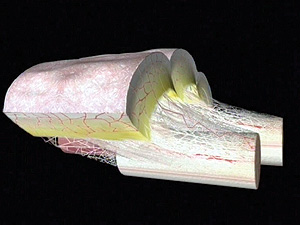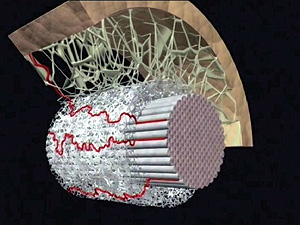Fascia and Myofascial Release
Fascia is a specialized system of the body that has an appearance similar to a spider's web or a sweater. Fascia is very densely woven, covering and interpenetrating every muscle, bone, nerve, artery and vein, as well as, all of our internal organs including the heart, lungs, brain and spinal cord. The most interesting aspect of the fascial system is that it is not just a system of separate coverings. It is actually one continuous structure that exists from head to toe without interruption. In this way you can begin to see that each part of the entire body is connected to every other part by the fascia, like the yarn in a sweater.
Trauma, inflammatory responses, and/or surgical procedures create Myofascial restrictions that can produce tensile pressures of approximately 2,000 pounds per square inch on pain sensitive structures that do not show up in many of the standard tests (x-rays, myelograms, CAT scans, electromyography, etc.) A high percentage of people suffering with pain and/or lack of motion may be having fascial problems, but are not diagnosed.
Fascia: A Liquid Crystalline Matrix

Fascia Photo by Permission of Dr. JC Guimberteau
My experience has shown that much of what you and I were taught has been known to be obsolete for close to seventy years! Despite the fact that the information has been known to be outdated, it is still being taught in most medical, dental, and therapeutic schools, leading to the frustration of temporary results and a health care system on the verge of bankruptcy and collapse.
It is time to change and update our paradigm, which is a shared set of assumptions, a model of reality. Our society's model of reality is logical, but a terribly flawed and incomplete paradigm.
I hope to share with you the principles that I have developed from my own personal experience with pain and gleaned from patients from around the world over decades. We will explore an exciting new paradigm of the Myofascial system that is emerging and the important concepts of piezoelectricity, fiber optics, mechanotransduction, fluid dynamics, quantum physics, fractal geometry, complexity and chaos theory, and cellular consciousness.
Fascia plays an important role in the support and function of our bodies, since it surrounds and attaches to all structures. In the normal healthy state, the fascia is relaxed and wavy in configuration. It has the ability to stretch and move without restriction. When one experiences physical trauma, emotional trauma, scarring, or inflammation, however, the fascia loses its pliability. It becomes tight, restricted, and a source of tension to the rest of the body. Trauma, such as a fall, car accident, whiplash, surgery or just habitual poor posture and repetitive stress injuries has cumulative effects on the body. The changes trauma causes in the fascial system influences comfort and function of our body. Fascial restrictions can exert excessive pressure causing all kinds of symptoms producing pain, headaches or restriction of motion. Fascial restrictions affect our flexibility and stability, and are a determining factor in our ability to withstand stress and perform daily activities.

Fascia Photo by Permission of Dr. JC Guimberteau
Trauma, inflammatory responses, and/or surgical procedures create Myofascial restrictions that can produce tensile pressures of approximately 2,000 pounds per square inch on pain sensitive structures that do not show up in many of the standard tests (x-rays, myelograms, CAT scans, electromyography, etc.)
The use of Myofascial Release allows us to look at each patient as a unique individual. Our one-on-one therapy sessions are hands-on treatments during which our therapists use a multitude of Myofascial Release techniques and movement therapy. We promote independence through education in proper body mechanics and movement, self treatment instruction, enhancement of strength, improved flexibility, and postural and movement awareness.
Nenhum comentário:
Postar um comentário